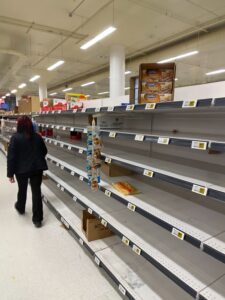The Holidays Might Be Over but Supply Chain Issues Are Not

Supply chain – two words, which have always been part of business lexicon, are now part of the consumer conversation. That’s because massive supply chain disruptions, which began as the pandemic hit in 2020, had cascading effects that not only impacted manufacturers and retailers, but also consumers. Materials and labor shortages in the manufacturing sector resulted in shipping delays to retailers, which emptied store shelves, created product shortages and increased prices for consumers.

Source: WeStarMoney from Pexels
Bottlenecks in the supply chain lingered throughout 2021. While some experts projected these supply chain issues might taper off in the new year, it seems supply chain problems will persist in 2022, creating challenges for companies and consumers. With supply chain issues expected to be a reality in 2022 and into 2023, brands must keep adapting strategies to keep products moving off the production line and onto store shelves.
Companies in every sector across the globe have been impacted by pandemic-driven supply chain disruptions. According to an Ernst & Young survey conducted in late 2020, serious disruptions affected 57% of companies, with 72% of these companies reporting a negative effect. Product shortages caused by these supply chain issues are also worrying to consumers. A KPMG study cited by USA Today found that 71% of grocery consumers are somewhat or very concerned about shortages or stockouts, with 35% switching brands when their favorite items are out of stock.
To help mitigate the impact of supply chain disruptions and create supply chain resiliency, brands should consider optimizing product packaging. Replacing packaging materials with lightweight, recyclable options reduces energy consumption and use of raw materials as well as reduces costs. Distribution efficiencies are also created in the supply chain as a result of lighter-weight packaging, which maximizes the amount of product in each shipment.
Many companies like us here at CCT have already made a material switch from steel to aluminum. Cost and sustainability are two factors driving this trend. It was recently reported that over the past year, steel prices were 300% above their pre-pandemic levels at more than $1,900 per ton. Before the pandemic, steel priced between $500 to $800 per ton. Infinitely recyclable and requiring less energy to produce than steel, brands are increasingly selecting aluminum as an alternative to steel in food and beverage product packaging including jar lids.
We introduced the world’s first aluminum lug jar lid last year on our EEASY Lid, designing this packaging innovation with sustainability and durability in mind. Strong, lightweight and corrosion resistant, CCT’s aluminum lug EEASY Lid is packaging optimized to help brands more easily navigate supply chain challenges, making the supply chain more efficient while reducing costs.